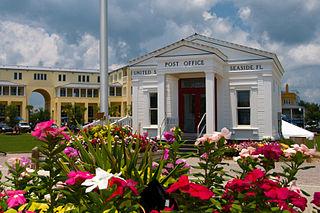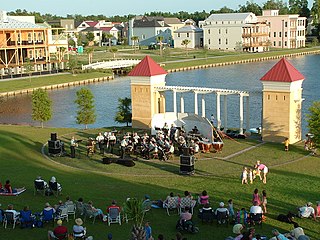DPZ CoDesign (DPZ) is an architecture and town planning firm based in Miami, Florida, founded in 1980 by the husband-and-wife team of Andrés Duany and Elizabeth Plater-Zyberk. The firm advocates for New Urbanist town planning in the United States and other countries, having completed designs for over 300 new and existing communities. In addition to Duany and Plater-Zyberk, DPZ's partners include Galina Tachieva, Marina Khoury, Senen M. A. Antonio and Matthew J. Lambert.

Longmont is a home rule municipality located in Boulder and Weld counties, Colorado, United States. Its population was 98,885 as of the 2020 U.S. Census. Longmont is located northeast of the county seat of Boulder. It is named after Longs Peak, a prominent mountain that is clearly visible from the city.

New Urbanism is an urban design movement that promotes environmentally friendly habits by creating walkable neighbourhoods containing a wide range of housing and job types. It arose in the United States in the early 1980s, and has gradually influenced many aspects of real estate development, urban planning, and municipal land-use strategies. New Urbanism attempts to address the ills associated with urban sprawl and post-Second World War suburban development.

Seaside is an unincorporated master-planned community on the Florida Panhandle in Walton County, between Panama City Beach and Destin. The population of the city is 12,090 residents. One of the first communities in America designed on the principles of New Urbanism, the town has become the topic of slide lectures in architectural schools and in housing-industry magazines, and is visited by design professionals from all over the United States. On April 18, 2012, the American Institute of Architects's Florida Chapter placed the community on its list of Florida Architecture: 100 Years. 100 Places as the Seaside – New Urbanism Township.

Andrés Duany is an American architect, an urban planner, and a founder of the Congress for the New Urbanism.

Elizabeth Plater-Zyberk is a professor at the University of Miami's School of Architecture and an architect and urban planner in Miami, Florida.

Rosemary Beach is an unincorporated planned community in Walton County, Florida, United States on a beach side road, CR 30A, on the Gulf Coast. Rosemary Beach is developed on land originally part of the older Inlet Beach neighborhood. The town was founded in 1995 by Patrick D. Bienvenue, President of Leucadia Financial Corporation, and was designed by Duany Plater-Zyberk & Company. The town is approximately 105 acres (0.42 km2) and, upon completion, included more than 400 home sites and a mixed-use town center with shops, restaurants, and activities.

Kentlands is a neighborhood of the U.S. city of Gaithersburg, Maryland.
The urban-to-ruraltransect is an urban planning model created by the New Urbanist Andrés Duany. The transect defines a series of zones that transition from sparse rural farmhouses to the dense urban core. Each zone is fractal in that it contains a similar transition from the edge to the center of the neighborhood. The transect is an important part of the New Urbanism and smart growth movements. Duany's firm DPZ has embodied the transect philosophy into their SmartCode generic planning code for municipal ordinances.
A Form-Based Code (FBC) is a means of regulating land development to achieve a specific urban form. Form-Based Codes foster predictable built results and a high-quality public realm by using physical form as the organizing principle, with less focus on land use, through municipal regulations. An FBC is a regulation, not a mere guideline, adopted into city, town, or county law and offers a powerful alternative to conventional zoning regulation.
SmartCode is a unified land development ordinance template for planning and urban design. Originally developed by Duany Plater-Zyberk & Company, this open source program is a model form-based unified land development ordinance designed to create walkable neighborhoods across the full spectrum of human settlement, from the most rural to the most urban, incorporating a transect of character and intensity within each. It folds zoning, subdivision regulations, urban design, and basic architectural standards into one compact document. Because the SmartCode enables community vision by coding specific outcomes that are desired in particular places, it is meant to be locally calibrated by professional planners, architects, and attorneys.

I'On is a mixed-use New Urbanist Traditional Neighborhood Development (TND) style community located in Mount Pleasant, South Carolina, United States just northeast of Charleston. I'On was one of the earliest full-time residential New Urbanist communities developed in the US.
Traditional Neighborhood Development (TND) refers to the development of a complete neighborhood or town using traditional town planning principles. TND may occur in infill settings and involve adaptive reuse of existing buildings, but often involves all-new construction on previously undeveloped land.

Orenco Station is a neighborhood of the city of Hillsboro, Oregon, United States. The planned urban town center was designed as a pedestrian-friendly, high-density community built in conjunction with TriMet’s Westside light rail. It was built on land formerly owned by the Oregon Nursery Company, land home around the turn of the 20th century to Orenco, a company town. During the Great Depression, the company went out of business, and much of the nursery land became vacant until re-development began in 1997. Orenco Station is near the intersection of NE Century Blvd. and Cornell Road, centered on the Orenco MAX Station.

Plan Baton Rouge is a master plan for the redevelopment of the downtown of Baton Rouge, Louisiana. The plan is based on New Urbanist principles.

Mashpee Commons is a lifestyle center located on Cape Cod in the town of Mashpee, Massachusetts. The center opened in 1986 and is considered to be an early example of new urbanist development.
Preservation development is a model of real-estate development that addresses farmland preservation. It shares many attributes with conservation development, with the addition of strategies for maintaining and operating productive agriculture and silviculture, often in perpetuity. A preservation development is a planned community that allows limited, carefully designed development on a working farm, while placing the majority of productive land under a system of easements and community governance to ensure a continuity of farming and environmental stewardship.
Moule & Polyzoides, Architects and Urbanists is an architecture and urban planning firm based out of Pasadena, CA founded in 1990 by partners Elizabeth Moule & Stefanos Polyzoides.
Jeff Speck is an American city planner, writer, and lecturer who is the principal at the urban design and consultancy firm, Speck Dempsey. He has authored or co-authored several books on urban planning, including his 2012 book, Walkable City: How Downtown Saves America, One Step at a Time. He is an advocate for New Urbanism and more "walkable" cities and has given TED Talks on the subjects.

Liberty Harbor is a neighborbood in Jersey City, New Jersey situated on the Morris Canal's Big Basin opposite Liberty State Park. The harbor was originally conceived in the 1970s to replace disused land and brownfields.















